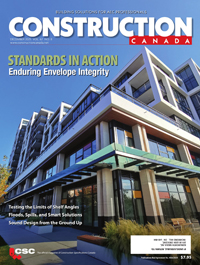Balancing building science and roof design
Construction document phase:
∞ Include the air barrier and the vapour retarder (when required) in the drawings;
∞ Identify specific components of the code-required air barrier system in the drawings;
∞ Include specification sections specific to the project, system, and material; and
∞ Provide details of the vapour retarder (when required), insulation, air barrier system, and weather-resistive barrier transitions (e.g. roof-to-wall) to ensure continuity and avoid the “by others” conundrum.
Bidding phase:
∞ Understand the risks of value engineering and life cycle cost implications (initial versus long-term costs); and
∞ Clearly communicate why components of the design are critical for long-term building performance and energy efficiency.
Construction administration phase:
∞ Review project submittals to ensure the specified products and systems are properly incorporated into the project and alternates are not substituted inappropriately.
Partnering with experts
The most successful buildings will not only meet the architect’s esthetic vision, but they will also be well-functioning for the occupant, as well as long-lasting, durable, and energy efficient. Building enclosure consultants who specialize in building science and energy modelling may be a valuable addition to a project team tasked with navigating the gap that sometimes exists between design and science.
It is also important, during the design and specification process, to work closely with product manufacturers that have experts on staff who understand building and roofing science, to ensure the correct products are used, and systems as designed will provide the expected performance to help lower an architect’s risk.
Author
 James R. Kirby, AIA, is a GAF building and roofing science architect. Kirby has a master’s degree in architecture—structures option, and is a licensed architect. He has 30 years of experience in the roofing industry covering low-slope, steep-slope, metal, SPF, vegetative, and rooftop photovoltaics. He understands the effects of heat, air, and moisture on a roof system. Kirby presents building and roofing science information to architects, consultants, and building owners, and he writes articles and blogs for building owners, facility managers, and the roofing industry at large. Kirby is a member of AIA, ASTM, ICC, IIBEC, NRCA, and WSRCA.
James R. Kirby, AIA, is a GAF building and roofing science architect. Kirby has a master’s degree in architecture—structures option, and is a licensed architect. He has 30 years of experience in the roofing industry covering low-slope, steep-slope, metal, SPF, vegetative, and rooftop photovoltaics. He understands the effects of heat, air, and moisture on a roof system. Kirby presents building and roofing science information to architects, consultants, and building owners, and he writes articles and blogs for building owners, facility managers, and the roofing industry at large. Kirby is a member of AIA, ASTM, ICC, IIBEC, NRCA, and WSRCA.







